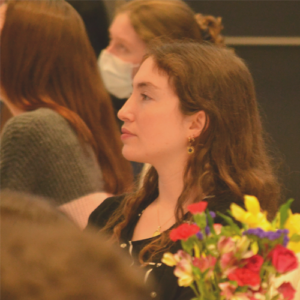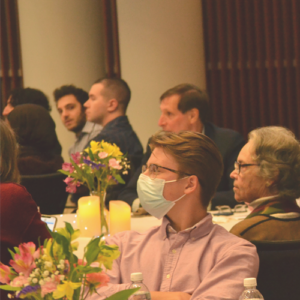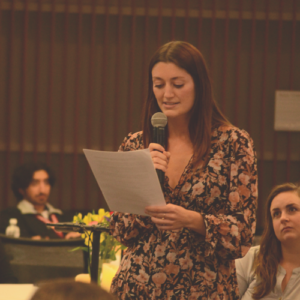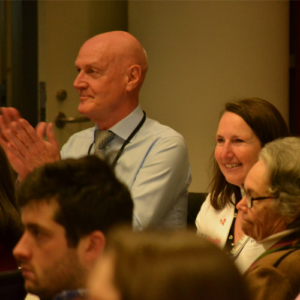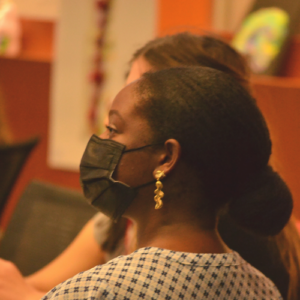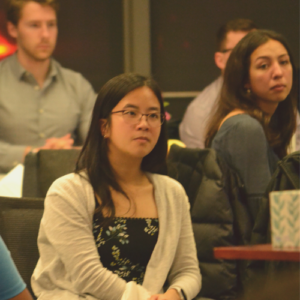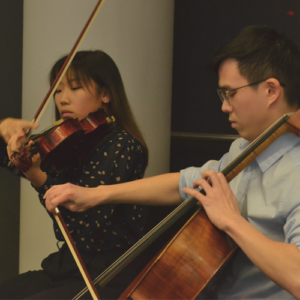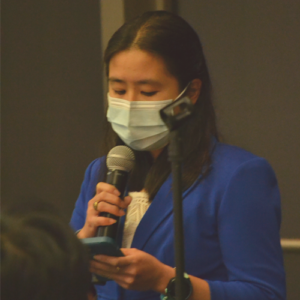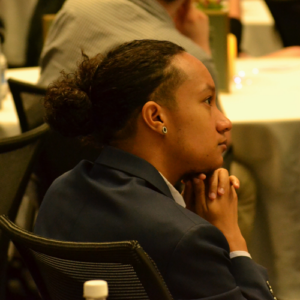 Medical students spend thousands of hours pouring over textbooks, models, and diagrams, which may teach them plenty about the human body. But a textbook has no loved ones. A model shows no signs of joy and pain. And a diagram has no life history. An anatomical donor, on the other hand, exposes second-year students to one of the most important aspects of patient care: what it means to be human.
Medical students spend thousands of hours pouring over textbooks, models, and diagrams, which may teach them plenty about the human body. But a textbook has no loved ones. A model shows no signs of joy and pain. And a diagram has no life history. An anatomical donor, on the other hand, exposes second-year students to one of the most important aspects of patient care: what it means to be human.
We are fortunate at UVA to have around 30 anatomical donors each year. These are people who made the choice to donate their bodies to further medical education. People who made a sacrifice to help others in the future.
“It’s a huge gift that, by no means, goes unappreciated. I think every single person in our class values the education that we got from this experience so much. It would be really difficult for us to learn this information without that sacrifice. So I think it’s crucial. And it’s a beautiful thing.” ~UVA School of Medicine student Emma Harrison
To show their appreciation for this incredible gift, Emma and her anatomy classmates planned a Convocation of Gratitude ceremony that took place on December 9.
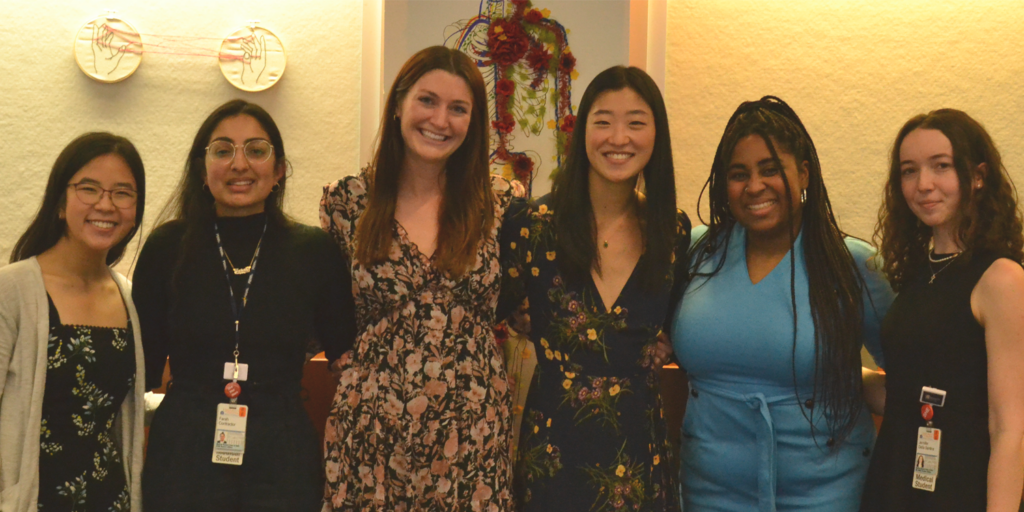
Convocation leadership team (lt to rt): Tuyet Minh-Tran, Farah Contractor, Emma Harrison, Ashley Zhang, Amber Bowman, and Jenny Della Santina
Emma, along with fellow ceremony co-chair Ashley Zhang, and PR chair Farah Contractor, shared the following thoughts about the ceremony and what it meant to them to work with donors.
What were your expectations before anatomy class, and how did those expectations compare to your own experiences?
Emma: I think that there was definitely a lot of fear and anxiety mixed with excitement because it is something that we will need to know and use every day. But there’s definitely a lot of anticipation walking in and seeing the donor on the table.
Farah: UVA did a good job of covering the history of anatomy from a social context and also preparing us emotionally for seeing the donor before the first day. We were asked to type up any emotions that we were having. This was class-wide, and we all got to say how we were feeling. A lot of emotions shared were anxiety, apprehension, excitement. We also had some sessions with the ethics faculty members to discuss how we were expected to act around our donors. How to be respectful, obviously, but also to maintain some sort of humanity while going through our classes. That was really helpful as well.
What role did these donors play in furthering your education?
Ashley: We get lots of information on anatomy: how organs are laid out, all the important structures that we should know, how everything is innervated, what blood supply goes there. But nothing really compares to actually approaching the donors and being able to see how those structures interact and how complex that anatomy can be. It’s not as simple as a model that we are given or a diagram. Being able to understand that and recognize the variation was really important. I know it’s not something that every medical school does, but I think for me, it was a very valuable part of my medical education. I don’t think it would have been the same without it.
Emma: I think it’s super different learning from a real person than it is from a diagram or a teacher. I’ve heard a lot of doctors talking about how this was a fundamental part of their medical education. It’s something that you don’t really ever forget — that first time you see your donor.
Do you learn about the donor prior to studying them?
Emma: I think we have the option to ask about them after we’re done. But we’re not given information before.
Ashley: I think it makes the situation a little more bearable in the beginning, when there is such an overwhelming amount of emotion already. On the first day, Dr. Moyer, our anatomy faculty leader, told us to look at our donors and recognize any personal parts of their bodies, any tattoos, if they’ve had any significant procedures and scars on their bodies. And even just seeing some of those marks on a person, that was hard enough, remembering that this person had a life, had experiences, and is now doing something great for our school and our class. But again, that’s very emotional.
Farah: I think UVA does a really good job of honoring their sacrifice and teaching us how to be respectful.
Why do you think it’s so important than to have this ceremony devoted to thanking these donors and their families?
Emma: I think that the ceremony has two aspects to it. I think that’s a really big part of it, to thank the families of the donors. Their family members have made a huge sacrifice for us. They’ve been waiting sometimes one to five years to get the cremation remains back. So I think having the ceremony provides a sense of closure for them, having them meet some of us, to hear how grateful we are and how it’s impacted our education is a really beautiful thing.
Farah: Another huge part of the ceremony … throughout the last few months, we were asked as a class and individually to create reflection pieces. That could have been artwork, poetry, any sort of artform that helped us process our emotions and reflect on our experiences with anatomy. That was a huge part of the end of class. Then we displayed all these pieces for the families at the ceremony, and we had a lot of performances as well, like music and poetry readings. I think that helped show the families how grateful we were and also helped us process our own emotions about the experience.
The ceremony took place on Dec. 9. How did it go?
Ashley: It went really well. It was both an online Zoom ceremony as well as an in-person ceremony. We had families join through both, and we had our entire class with us in person as well. There were 160 classmates, around 15 faculty members, five family members who joined us in person, and around 20 joined over Zoom.
The performances were wonderful. Our classmates are extremely talented. And it was just such a wonderful thing to be able to share with each other our emotions through different avenues that we traditionally do not get to see each other. We had several musical performances. A lot of artwork was displayed, and it was just all beautifully created. The families also got to take turns speaking about how they remember their loved ones and the lives that their loved ones led. It was a very emotional experience for a lot of our classmates for sure. But it was just so wonderful to hear. And I think, while we didn’t get to learn a lot about the donor’s personal history before anatomy, being able to learn about it now means the world.
Farah: We had the ceremony in the Learning Studio, which is part of the medical school. Traditionally, we are in there all the time for classes. We redecorated the whole thing so that it felt like a formal, celebratory environment. We had flowers and tablecloths on the tables. We hung up all the artwork, and we printed out huge portraits of donors as well as that families sent us. We created a magazine with everyone’s artwork and poetry to give out to the families. There were just so many aspects of it that felt like tradition, and it was just a really beautiful thing to partake in.
Emma: We feel really happy with how it went because we’ve heard both from our classmates and from family members how much they enjoyed it and appreciate it. I think, based on that alone, I would say it was a success.
Were there any donor stories that stood out?
Ashley: Oh, yes. For me, at least, the story about one of the donors who was a graduate of UVA. He went here for undergrad for a degree in business administration. He loved UVA; it was very obvious. He was Phi Beta Kappa, Omicron Delta Kappa, a Raven Society member, extremely accomplished and extremely intertwined with the community. You don’t get to choose where your body goes. It’s kind of random amongst the Virginia schools, and I think the fact that he was, by chance, placed here and able to help UVA medical students is just such a beautiful coincidence. And I think it made the family really happy as well.
Emma: We also heard another story of one woman who was one of our donors. She spent her whole life teaching. Her husband talked about her for a long time. She was a kindergarten teacher and he just went on and on about how patient she was with her kiddos, and how much teaching really was her pride and joy and how amazing it is that she is still teaching today. I thought that was really special.
Farah: In all the stories, it seemed that a common thread throughout every single one was that these donors, they made it their life’s mission to help people. That was what their lives were about. And so the fact that they continued to serve us even after they passed away is incredible, and we’re so thankful for that.
What impact did this experience have on your relationship with your classmates?
Ashley: Oh, it absolutely impacted us. I remember on the first day of class, all of us being in the locker room beforehand. We were sharing in our jitters just because no one else really understands this kind of feeling and emotion of having to approach a human body and learn from it. So the fact that, a year later, after our anatomy courses concluded, that we can come back together and really provide us all with a sense of closure, and a sense of gratitude and appreciation, is fantastic.
Emma: I think traditionally medical school has been kind of unemotional — you put your head in the books and you just get down and you do it. Having learned about the history of the anatomy lab and also prefacing it with the ethics classes, I think it was really special that we were able to address all of these emotions that we had rather than not talking about it. It was a really special space to see all of our classmates express those emotions together.
What would you say to someone who is considering becoming an anatomical donor?
Ashley: I think it’s a really selfless thing to think about a future generation of physicians. You know, huge hordes of young people that you have never met and want to contribute to their education and help us treat our patients in the future. It’s not just benefiting us. It’s benefiting all of our patients in the future as well. I think that it’s a huge gift.
Article written by Holly Ford. Photos are by Emily May.
Filed Under: Education

